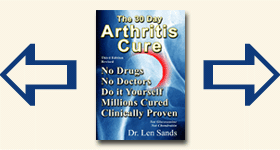Not Glucosamine - Not Chondroitin
The “Arthritis Cure” that isn’t
The so-called “medical miracle” described in the book, The Arthritis Cure, published by St. Martins Press, has been justifiably disputed by most well informed medical professionals. Let us go on record, clearly and unequivocally, that the treatments described in that book certainly are not a cure for arthritis any more than aspirin is a cure for arthritis.Although the use of glucosamines and chondroitins urged by the book can often produce good short-term effects, it has rarely shown any long-lasting value. That’s because glucosamines and chondroitins are merely the building blocks for the body to construct new cartilage. They help the body produce replacement cartilage at a faster rate, but they do nothing to stop the destruction of the arthritic process itself. The best one can hope for is to temporarily replace cartilage as fast as, or possibly even a little faster than it’s being destroyed. But usually, and inevitably, the destruction outpaces the repair and arthritis continues to worsen. That’s no “cure”!
Stopping the symptoms doesn’t stop the disease
There have been thousands of volumes written by thousands of authors on the how-and-why theories of arthritis. There are almost as many different theories as there are authors. Some of them are pretty screwy, but all of them are pretty scary.The scary part is that no one has been able to stop the relentless, destructive advance of arthritis - until now!
Sure, you may sometimes slow it down a bit through diet and nutritional supplements. You can ease the symptoms with anti-inflammatory drugs and pain relievers. Your doctor can clobber your system with highly toxic anti-cancer drugs like Methotrexate (also disguised under the less frightening name of Rheumatrex), which just maybe could give you some temporary relief at the cost of sacrificing your liver. But, until now, nobody has been able to halt the destructive onslaught against your cartilage and your joints.
Glucosamine Sulphate
Glucosamine is a nutritional marvel of medical science. Glucosamine has received a great deal of attention over the past few years because of its benefits for rebuilding cartilage and connective tissue that has been destroyed as a result of the arthritic process, from aging, or physical trauma damage. Its benefits have eased the suffering of millions around the world. Although touted as a cure, it is not. Glucosamine does not stop or slow down autoimmune attacks against the joints. Nevertheless, it is of enormous value because it promotes the production of special biochemicals called proteoglycans, which are water-retaining molecules that are the building blocks of collagen, cartilage, and connective tissue. Unfortunately, over the long run arthritis often destroys cartilage faster than the body can replace it even with the help of glucosamine supplements. Fortunately CMO can, and usually does, halt the arthritic process itself. Glucosamine and CMO support each other’s benefits and work together superbly.Once CMO has stopped the arthritic process, and halted the continuing destruction of cartilage, the body is then free to build up cartilage to normal levels again. But cartilage production is normally a very slow process. Glucosamine sulphate can speed up cartilage replacement dramatically. Ample cartilage levels are necessary to regain normal joint function and eliminate joint pain. Obviously cartilage replacement cannot be accomplished in an instant.
Connective tissues are chiefly made of collagen, a tough stringy protein. Collagen is a major tissue in the human body, making up almost 30% of total body protein content. The building and rebuilding of collagen in the body is a constant process. During periods of stress, exercise, or wear the demand for the building blocks of collagen and proteoglycans increases. More glucosamine in needed to keep up with this demand. The body makes glucosamine from glucose, but there are no significant food sources of glucosamine. Taking supplemental glucosamine stimulates the production of the collagen needed to make connective tissue.


